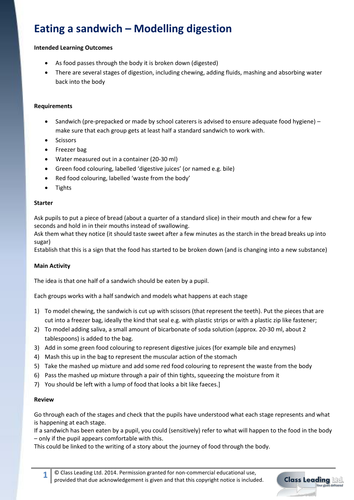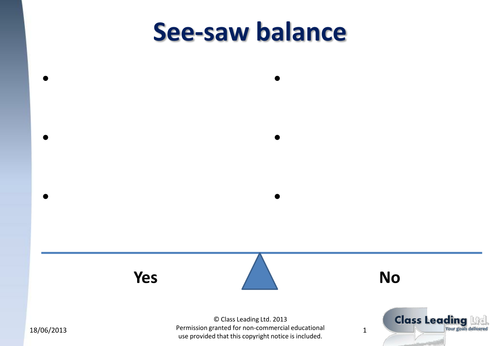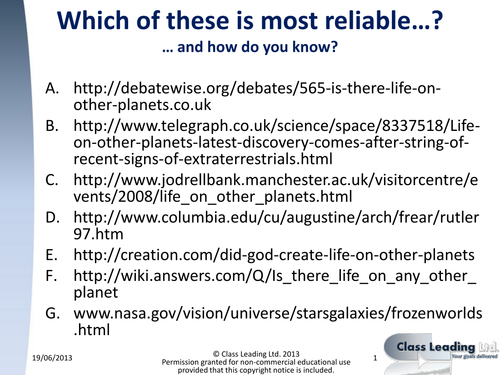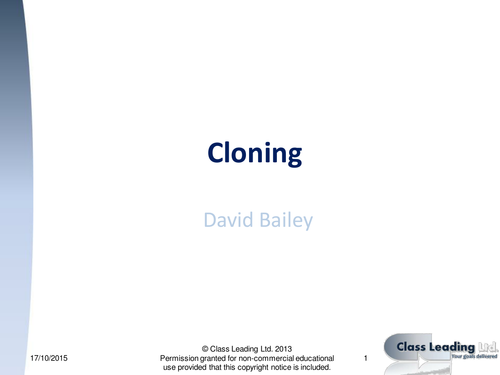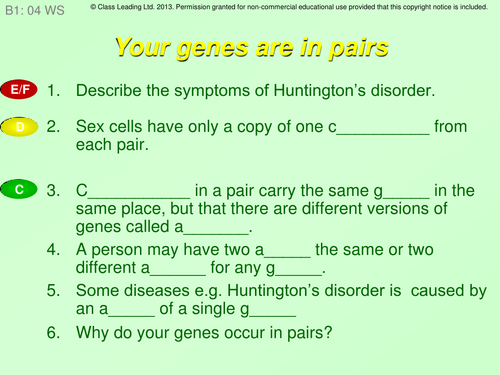314Uploads
262k+Views
194k+Downloads
Biology

The Carbon Cycle - Extracting info from a text
Keywords: Carbon cycle, photosynthesis, respiration, decomposition, combustion.
An activity sheet and guidance sheet (with answers highlighted) in which students extract information from a text and then use this to identify the processes in the carbon cycle and ultimately construct a diagram from these. These can then be compared to one published in a textbook to allow students to make corrections. This works exceptionally well as a peer assessed activity.

Eating a sandwich - modeling digestion
There are two parts to this activity, one is a practical activity to model the process of digestion. The other is a powerpoint slideshow to show what happens to the food on its journey through the body. If using with KS3 then the learning outcomes on the activity plan could also include breaking up of molecules in digestion. If using with KS2 for the new curriculum, the powerpoint will include some terms/slides that you may wish to miss out, so it has been left in an editable form.\nPlease ensure that you carry out a risk assessment before carrying out a practical activity.

Food chains and energy transfer - questions
This is a worksheet based activity that includes some higher order thinking to explore the ideas around energy transfer in simple food chains. Two versions are included, one with legacy GCSE grades, the other without. (please note that grade indications are only approximate). Why not try getting learners to choose a selection of questions to answer (e.g. do Q1-4 or Q3-8) An answer sheet is included.
This resource was originally designed for OCR 21st Century Science unit B3.
A premium editable version of this is available at: https://www.tes.com/teaching-resource/-11858631
Keywords: energy, transfer, food chain, efficiency

The carbon cycle - grade questions
This activity contains a powerpoint with graded questions & answers and matching pupil activity sheets, designed to be used at the end of a lesson and/or the start of the next lesson to review previous learning. The questions are based on the previous OCR 21st Century Science Specification unit P2, although could be used with other exam boards.\nClicking through the show reveals answers one a time. These reduce to A5 easily, the ideal size for most pupils. Please note grades are approximate.

Weighing up arguments - See saw writing frame
This resource is a collection of 6 slightly different see-saw balances that can be used with learners to help them develop the skills to weigh up an argument. The idea is that students will list reasons on both side of an argument (e.g. Should we have Nuclear Power?). They then use this to help make a decision. The scoring column on some sheets allows learners to score each argument out of a maximum of say 3. Add the scores on each side to see which has the stronger argument. This also includes phrases to support a more detailed conclusion. This was inspired by 21st Century Science.

Evaluating websites from URLs
This resource is a short powerpoint show and a pdf of the first slide. The idea is that learners read the URLs for a series of websites and decide whether they are trustworthy. They could put them into one of say three categories (e.g. High, Medium. Low).This is great for stimulating debate amongst learners, especially if the task is completed as a group. It is very effective when learners are asked to explain their reasoning. The powerpoint show can then be used to develop understanding further.

Genetics decision making (2) - graded questions
This activity contains a powerpoint with graded questions & answers and matching pupil activity sheets, designed to be used at the end of a lesson and/or the start of the next lesson to review previous learning. The questions are based on the previous OCR 21st Century Science Specification unit B1, although could be used with other exam boards.\nClicking through the show reveals answers one a time. These reduce to A5 easily, the ideal size for most pupils. Please note grades are approximate.

Can we choose our children - graded questions
This activity contains a powerpoint with graded questions & answers and matching pupil activity sheets, designed to be used at the end of a lesson and/or the start of the next lesson to review previous learning. The questions are based on the previous OCR 21st Century Science Specification unit B1, although could be used with other exam boards.\nClicking through the show reveals answers one a time. These reduce to A5 easily, the ideal size for most pupils. Please note grades are approximate.

Gene therapy - graded questions
This activity contains a powerpoint with graded questions & answers and matching pupil activity sheets, designed to be used at the end of a lesson and/or the start of the next lesson to review previous learning. The questions are based on the previous OCR 21st Century Science Specification unit B1, although could be used with other exam boards.\nClicking through the show reveals answers one a time. These reduce to A5 easily, the ideal size for most pupils. Please note grades are approximate.

Cloning - graded questions
This activity contains a powerpoint with graded questions & answers and matching pupil activity sheets, designed to be used at the end of a lesson and/or the start of the next lesson to review previous learning. The questions are based on the previous OCR 21st Century Science Specification unit B1, although could be used with other exam boards.\nClicking through the show reveals answers one a time. These reduce to A5 easily, the ideal size for most pupils. Please note grades are approximate.

Where did life begin - graded questions
This activity contains a powerpoint with graded questions & answers and matching pupil activity sheets, designed to be used at the end of a lesson and/or the start of the next lesson to review previous learning. The questions are based on the previous OCR 21st Century Science Specification unit B3, although could be used with other exam boards.\nClicking through the show reveals answers one a time. These reduce to A5 easily, the ideal size for most pupils. Please note grades are approximate.

Cell communication - graded questions
This activity contains a powerpoint with graded questions & answers and matching pupil activity sheets, designed to be used at the end of a lesson and/or the start of the next lesson to review previous learning. The questions are based on the previous OCR 21st Century Science Specification unit B3, although could be used with other exam boards.\nClicking through the show reveals answers one a time. These reduce to A5 easily, the ideal size for most pupils. Please note grades are approximate.

Darwin natural selection - graded questions
This activity contains a powerpoint with graded questions & answers and matching pupil activity sheets, designed to be used at the end of a lesson and/or the start of the next lesson to review previous learning. The questions are based on the previous OCR 21st Century Science Specification unit B3, although could be used with other exam boards.\nClicking through the show reveals answers one a time. These reduce to A5 easily, the ideal size for most pupils. Please note grades are approximate.

Variety of life - graded questions
This activity contains a powerpoint with graded questions & answers and matching pupil activity sheets, designed to be used at the end of a lesson and/or the start of the next lesson to review previous learning. The questions are based on the previous OCR 21st Century Science Specification unit B3, although could be used with other exam boards.\nClicking through the show reveals answers one a time. These reduce to A5 easily, the ideal size for most pupils. Please note grades are approximate.

Stem cells - graded questions
This activity contains a powerpoint with graded questions & answers and matching pupil activity sheets, designed to be used at the end of a lesson and/or the start of the next lesson to review previous learning. The questions are based on the previous OCR 21st Century Science Specification unit B1, although could be used with other exam boards.\nClicking through the show reveals answers one a time. These reduce to A5 easily, the ideal size for most pupils. Please note grades are approximate.

Your genes are in pairs
This activity contains a powerpoint with graded questions & answers and matching pupil activity sheets, designed to be used at the end of a lesson and/or the start of the next lesson to review previous learning. The questions are based on the previous OCR 21st Century Science Specification unit B1, although could be used with other exam boards.\nClicking through the show reveals answers one a time. These reduce to A5 easily, the ideal size for most pupils. Please note grades are approximate.

Finding out about genes - graded questions
This activity contains a powerpoint with graded questions & answers and matching pupil activity sheets, designed to be used at the end of a lesson and/or the start of the next lesson to review previous learning. The questions are based on the previous OCR 21st Century Science Specification unit B1, although could be used with other exam boards.\nClicking through the show reveals answers one a time. These reduce to A5 easily, the ideal size for most pupils. Please note grades are approximate.

Why things vary
This activity contains a powerpoint with graded questions & answers and matching pupil activity sheets, designed to be used at the end of a lesson and/or the start of the next lesson to review previous learning. The questions are based on the previous OCR 21st Century Science Specification unit B1, although could be used with other exam boards.\nClicking through the show reveals answers one a time. These reduce to A5 easily, the ideal size for most pupils. Please note grades are approximate.

Genetics decision making (1) - graded questions
This activity contains a powerpoint with graded questions & answers and matching pupil activity sheets, designed to be used at the end of a lesson and/or the start of the next lesson to review previous learning. The questions are based on the previous OCR 21st Century Science Specification unit B1, although could be used with other exam boards.\nClicking through the show reveals answers one a time. These reduce to A5 easily, the ideal size for most pupils. Please note grades are approximate.

How does evolution happen - graded questions
This activity contains a powerpoint with graded questions & answers and matching pupil activity sheets, designed to be used at the end of a lesson and/or the start of the next lesson to review previous learning. The questions are based on the previous OCR 21st Century Science Specification unit B3, although could be used with other exam boards.\nClicking through the show reveals answers one a time. These reduce to A5 easily, the ideal size for most pupils. Please note grades are approximate.


